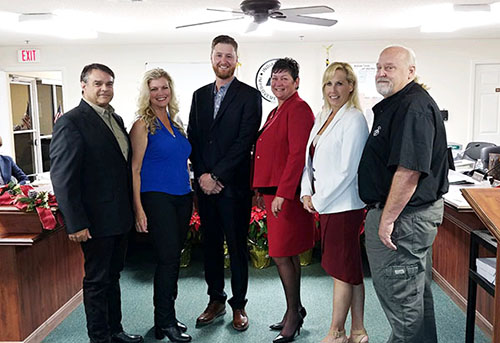The Indian Trail Improvement District Board of Supervisors agreed Wednesday, June 19 to a traffic calming and intersection improvement plan presented by engineer Joe Capra of Captec Engineering.
“We spent the last 30 days working on this stop sign study,” Capra said. “The board asked us to work on it in March, and a couple of things we’ve been doing is looking at intersections that we could possibly add more stop signs, from possibly a two-way to a four-way stop. The intention is, of course, as we do with all our traffic calming, to reduce accidents and try to make it a bit safer.”
Capra said the firm looked at the 10 worst intersections in The Acreage for accidents.
“We inventoried all 10 intersections, and we actually put traffic volume counters and measured speeds at four of those intersections, and that helped us make the recommendations that we have,” Capra said, adding that he also used accident data provided by the county to evaluate the conditions. “We’ve been following the accident data for more than five years, and they don’t seem to be getting much better.”
Capra also looked at “line of sight,” the distance a driver could see down the intersecting roadway before pulling onto it.
“We have areas where there are [communication] boxes and different things in the way, so we made some recommendations on sight distances, and then we went out and did the volume and speed analysis,” he said.
The final recommendations for the intersections are not all the same. “We ask that you consider upgrades to the LED flashing stop signs, for example, that you put up on Northlake [Blvd.] and Hall [Blvd.],” Capra said. “We recommend that you place those at these intersections.”
Capra added that too many of the advance warning signs are missing.
“There’s a couple of them that need speed cushions or speed tables. We’re recommending the speed tables that you used in the pilot program,” he said.
He added that Palm Beach County Fire-Rescue is participating in the district’s study on 140th Avenue North for approval of a two-hump traffic table that emergency vehicles can get through quickly.
“We’re converting most of the intersections from two-way stops to four-way stops,” Capra said. “We recommend removing line-of-sight obstructions. I have to tell you it is difficult to get those [communication] boxes moved, so we are going to adjust our striping, safely of course, to make sure that people can get out there and see ahead of the crosswalks, for example.”
ITID President Betty Argue asked if the district did not have the right to demand that the communication boxes be moved, and Capra said the district probably has the right, but getting the companies to cooperate quickly is another matter. “If we have an option to avoid that, I would recommend it,” Capra said.
Intersections on the list for changes or improvements with high priority are four-way stops at Coconut and Orange Grove, Avocado and Key Lime, 140th and Temple, Hall and Key Lime, and 140th and Citrus Grove. Intersections with medium priority are speed tables at Mandarin and Hamlin and a four-way stop at Hall and Citrus Grove. Intersections with lower priority are for signage at Mandarin and Temple and a four-way stop at Hall and Temple.
Argue pointed out that the purpose of the study was to get the county to support the locations for four-way stop signs.
“Right now, we don’t have the approval to do that,” she said. “That has been the stopping block all along. I fully support sending it along to the county with your recommendations that are set up here, and we can work with staff in terms of what we need to do with improvements in-house.”
Supervisor Tim Sayre made a motion to forward the recommendations to the county, which carried 5-0.








